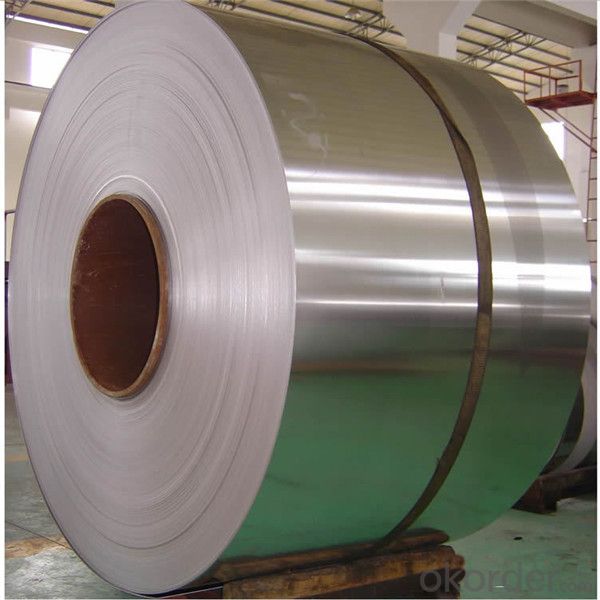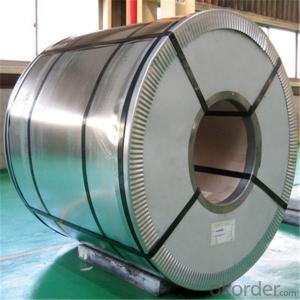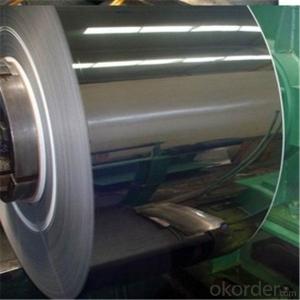AISI 304 Stainless Steel Coil for sink cold rolled
- Loading Port:
- Shanghai
- Payment Terms:
- TT OR LC
- Min Order Qty:
- 5 m.t.
- Supply Capability:
- 20000 m.t./month
OKorder Service Pledge
OKorder Financial Service
You Might Also Like
Item specifice
Products details of stainless steel coil
201 304 cold rolled stainless steel coils
Material:201,410,430,304,316,316L
Surface finish:2B,BA,No.4,6K,8K,HL,4K and so on
Thickness:0.15mm to 4.00mm
Width:15mm—3000mm
Weight:per actual weight
Application:kitchenware,cookware, metal decoration material, construction and building ornament, door, machine,building,ship plate,product parts manufacturing and stainless steel products tooling, steel spare and accessory parts,etc.
201 304 cold rolled stainless steel coils show:
Packaging & Shipping
Packing and shipping information of stainless steel coil
201 304 cold rolled stainless steel coils
Payment: T/T 30% deposit, Balance against the copy of B/L; or L/C at sight
Package: Export standard Package(Water Proof Paper/ PVC Cover+Wooden Pallet)
Shipment: 15 to 30 days after the receipt of the deposit
Ship term: FOB Huangpu / Foshan port or CNF import port
Minimum quantity: 5 Metric Ton
201 304 cold rolled stainless steel coils
Product/service(we sell): Cold Rolled Steel Coil/strip/sheet/circle/tube/pipe,and etc.
Main market: Taiwan, South-East Asia, Mid-East, India , Russian, South America, and etc.
3) Product picture display:


- Q:Can stainless steel strips be plated or coated with another metal?
- Yes, stainless steel strips can be plated or coated with another metal. The process of plating or coating stainless steel involves depositing a layer of another metal onto the surface of the stainless steel strip. This can be done for various reasons such as enhancing the appearance, providing corrosion resistance, improving hardness or lubricity, or for electrical conductivity. The plating or coating can be achieved through different methods such as electroplating, electroless plating, physical vapor deposition (PVD), or chemical vapor deposition (CVD). Each method has its own advantages and limitations, and the choice of plating or coating method depends on the desired properties and application requirements. It is important to consider factors such as compatibility between the stainless steel and the plating or coating material, thickness of the plating or coating layer, and the specific environmental conditions the stainless steel strips will be exposed to. Overall, plating or coating stainless steel strips with another metal is a common practice in various industries to achieve desired functional or decorative properties.
- Q:What are the recommended packaging methods for 111 stainless steel strips?
- The recommended packaging methods for 111 stainless steel strips typically involve using protective materials such as plastic or paper to wrap each strip individually. These wrapped strips are then placed in a sturdy cardboard box or wooden crate, ensuring proper cushioning and securing them to prevent any damage during transportation or storage.
- Q:What are the recommended storage and transportation conditions for 111 stainless steel strips?
- To prevent corrosion, it is advised to store and transport 111 stainless steel strips in a clean and dry environment. It is recommended to keep them in a well-ventilated, covered area free from moisture and excessive humidity. Storing the strips horizontally is necessary to prevent warping or bending. Moreover, it is crucial to shield the strips from chemicals, acids, and other substances that cause corrosion. When transporting, it is essential to securely package the strips using suitable materials like wooden crates or cardboard boxes. They should be appropriately wrapped or padded to avoid damage from vibration or impact during transit. Using moisture-resistant packaging is also suggested to prevent moisture absorption during transportation. By following these storage and transportation guidelines, the quality and integrity of the 111 stainless steel strips will be ensured.
- Q:Are stainless steel strips resistant to corrosion?
- Stainless steel strips possess corrosion resistance due to their composition. They consist of iron, chromium, and other elements that create a protective layer on the metal's surface. This layer, referred to as a passive film, acts as a barrier between the metal and oxygen and moisture, which are the primary factors behind corrosion. The formation of this protective film is attributed to the chromium content in stainless steel. The higher the chromium content, the greater the corrosion resistance. Consequently, stainless steel strips are renowned for their exceptional ability to withstand corrosion, rendering them suitable for numerous applications across diverse industries.
- Q:Can 111 stainless steel strips be etched or engraved for customization?
- Indeed, customization is possible for 111 stainless steel strips through etching or engraving. Stainless steel, being a versatile material, lends itself well to these processes, which can be achieved using different techniques like chemical etching, laser engraving, or mechanical engraving. By employing these methods, the stainless steel strips can be customized with utmost precision and intricate details, thereby offering limitless options for personalization or branding objectives. To achieve the desired outcome and identify the most appropriate technique for the specific customization requirements, it is advisable to seek guidance from a professional engraver or etcher.
- Q:Can stainless steel strips be used in telecommunications equipment?
- Indeed, in telecommunications equipment, stainless steel strips find utility. Frequently, stainless steel is opted for due to its robustness, resistance to corrosion, and strength. These attributes render stainless steel strips apt for an array of applications in telecommunications equipment, including cable support brackets, antenna mounts, enclosures, and cable trays. The resistance of stainless steel to rust and corrosion guarantees unwavering reliability and functioning of the equipment, even in the face of severe environmental conditions. Furthermore, the strength of stainless steel empowers it to endure the weight and strain of hefty equipment and cables, thereby establishing it as the favored choice in the telecommunications industry.
- Q:Can stainless steel strips be used in electrical applications?
- Yes, stainless steel strips can be used in electrical applications. Stainless steel is known for its high resistance to corrosion and heat, making it suitable for various electrical components like connectors, terminals, and conductors. Additionally, stainless steel's excellent mechanical properties and conductivity make it a reliable choice for applications where electrical conductivity and durability are required.
- Q:What are the common uses of stainless steel strips in the chemical manufacturing process?
- Due to their numerous advantageous properties, stainless steel strips are commonly employed in the chemical manufacturing process. One significant application of these strips is in the construction of storage tanks and vessels, where their excellent corrosion resistance is essential for handling and storing highly corrosive chemicals. Additionally, the high strength and durability of stainless steel strips enable them to withstand the harsh conditions often found in chemical manufacturing facilities. Another prevalent use of stainless steel strips in chemical manufacturing is in the production of heat exchangers. These play a critical role in maintaining precise temperature control during chemical reactions and processes. Stainless steel strips are preferred for this purpose due to their exceptional thermal conductivity and ability to resist oxidation at high temperatures. These properties ensure efficient heat transfer and prolong the operational lifespan of the heat exchangers, ultimately contributing to the overall productivity of the chemical manufacturing process. Moreover, stainless steel strips are utilized in the fabrication of various piping systems within chemical plants. These strips are used to manufacture pipes, fittings, and valves that transport and control the flow of chemicals throughout the manufacturing process. The corrosion resistance of stainless steel, which protects against both the chemicals being transported and external factors like moisture and humidity, makes it an ideal material choice for these critical components. Furthermore, stainless steel's non-porous nature and ease of cleaning make it suitable for industries where maintaining a high level of cleanliness and purity is crucial. Additionally, stainless steel strips find application in the production of filtration systems used in chemical manufacturing. These systems are responsible for removing impurities and contaminants from chemical solutions, ensuring the final product meets required specifications. Stainless steel strips, with their excellent chemical resistance and mechanical strength, are often incorporated into filter screens and membranes, providing reliable and efficient filtration performance. In conclusion, stainless steel strips are extensively utilized in the chemical manufacturing process due to their exceptional corrosion resistance, durability, thermal conductivity, and hygienic properties. Whether in storage tanks, heat exchangers, piping systems, or filtration systems, stainless steel strips contribute to the efficiency, safety, and quality of chemical production.
- Q:What are the different types of edge finishes for stainless steel strips?
- There are several different types of edge finishes that can be applied to stainless steel strips to enhance their appearance and functionality. One common edge finish is the straight edge, which is simply a straight cut along the edge of the strip. This is commonly used for industrial applications where appearance is not a priority. Another common edge finish is the deburred edge, which involves removing any sharp or jagged edges from the strip. This is important for safety reasons, as it prevents accidental cuts or injuries. A more decorative edge finish is the rounded edge, which involves rounding off the edges of the strip to create a smooth and polished look. This is often used for architectural or decorative purposes, as it gives the stainless steel strip a more refined and elegant appearance. A beveled edge finish is also popular, where the edges of the strip are cut at an angle to create a chamfered or sloped edge. This is commonly used in applications where a seamless transition is needed, such as for joining two strips together. Additionally, there are edge finishes that involve applying a coating or treatment to the edge of the stainless steel strip. This could include applying a protective film to prevent corrosion or applying a colored coating for aesthetic purposes. Overall, the choice of edge finish for stainless steel strips depends on the specific requirements of the application, such as functionality, safety, or aesthetics.
- Q:How do you prevent stainless steel strips from rusting?
- There are several measures you can take to prevent rusting of stainless steel strips: 1. Keep stainless steel clean by regularly washing it with mild soap or detergent and warm water. This will eliminate any dirt, grime, or contaminants that can cause corrosion. 2. Avoid using harsh or abrasive cleaners that can scratch the surface of stainless steel. Instead, opt for non-abrasive cleaners and use soft cloths or sponges for cleaning. 3. Ensure that the stainless steel strips are completely dry after cleaning. Any moisture left on the surface can lead to rust formation. Use a clean, dry cloth or towel to remove any remaining moisture. 4. Promptly remove any rust spots that appear on the stainless steel strips. Gently scrub the affected area with a stainless steel cleaner or a mixture of baking soda and water. Rinse thoroughly and dry the area to prevent further corrosion. 5. Consider applying a protective coating specifically designed for stainless steel. These coatings create a barrier between the metal and the environment, preventing rust formation. Follow the instructions provided by the manufacturer for proper application and reapplication. 6. Keep stainless steel away from corrosive substances such as acids, bleach, or saltwater. If contact occurs, rinse the affected area immediately with plenty of clean water and ensure thorough drying. 7. Store stainless steel strips in a dry environment when not in use. Moisture and humidity can contribute to rust formation. Consider using desiccant packs or silica gel to absorb any moisture in the storage area. By implementing these preventive measures, you can significantly reduce the likelihood of rusting and ensure the long-lasting appearance of your stainless steel strips.
1. Manufacturer Overview |
|
|---|---|
| Location | |
| Year Established | |
| Annual Output Value | |
| Main Markets | |
| Company Certifications | |
2. Manufacturer Certificates |
|
|---|---|
| a) Certification Name | |
| Range | |
| Reference | |
| Validity Period | |
3. Manufacturer Capability |
|
|---|---|
| a)Trade Capacity | |
| Nearest Port | |
| Export Percentage | |
| No.of Employees in Trade Department | |
| Language Spoken: | |
| b)Factory Information | |
| Factory Size: | |
| No. of Production Lines | |
| Contract Manufacturing | |
| Product Price Range | |
Send your message to us
AISI 304 Stainless Steel Coil for sink cold rolled
- Loading Port:
- Shanghai
- Payment Terms:
- TT OR LC
- Min Order Qty:
- 5 m.t.
- Supply Capability:
- 20000 m.t./month
OKorder Service Pledge
OKorder Financial Service
Similar products
New products
Hot products
Hot Searches
Related keywords



























